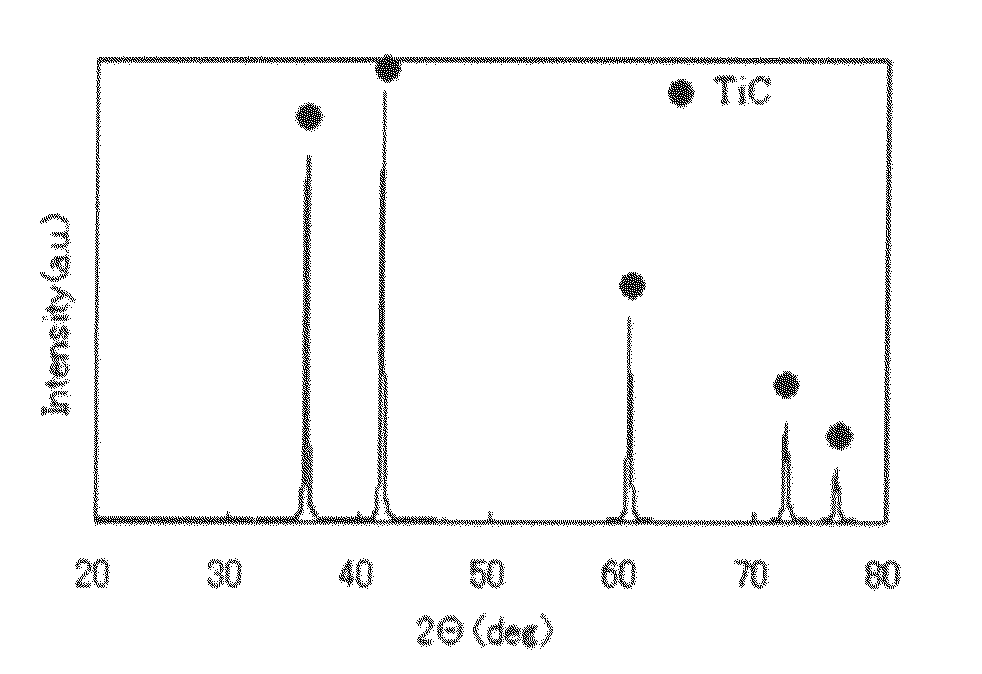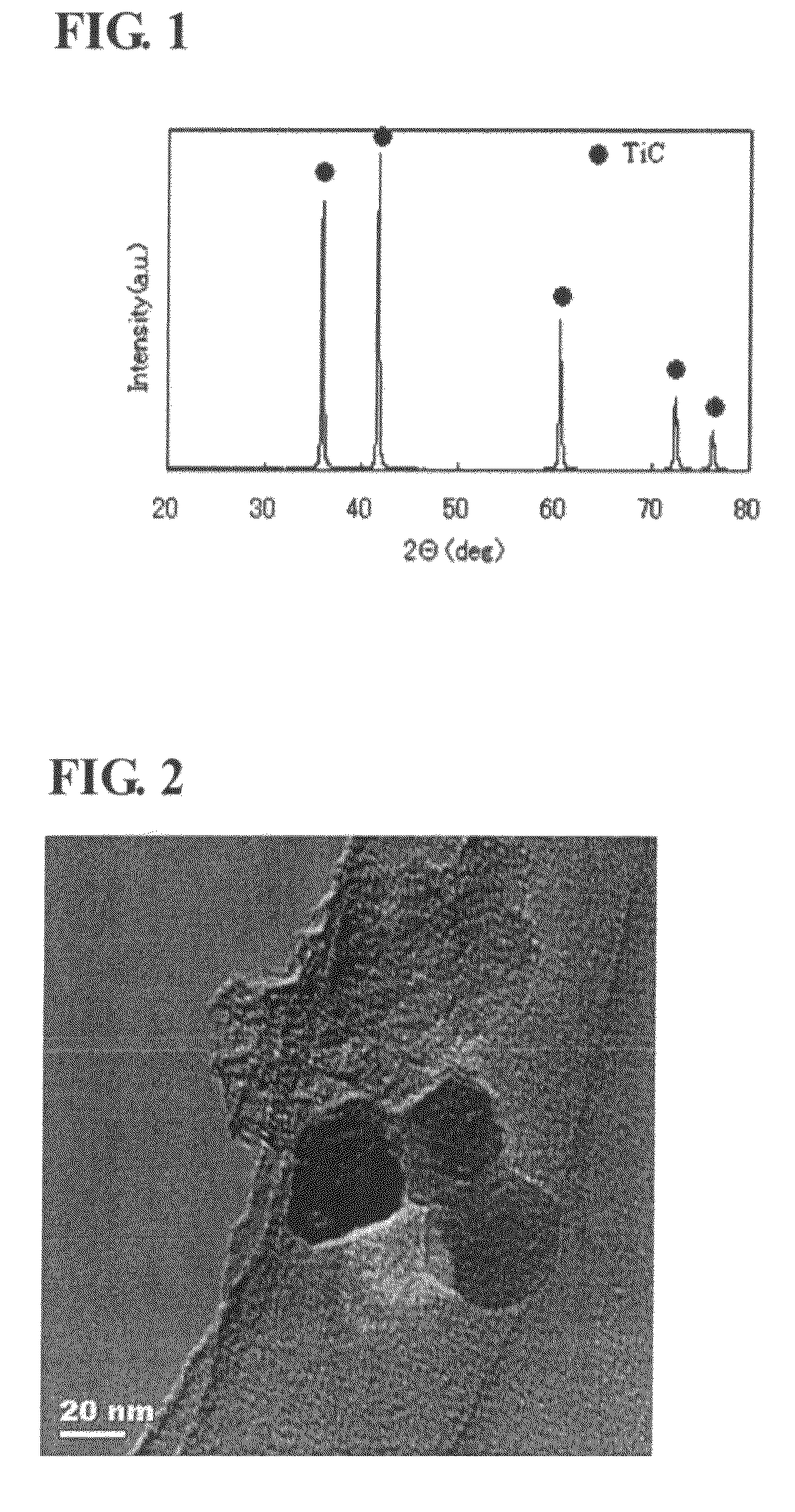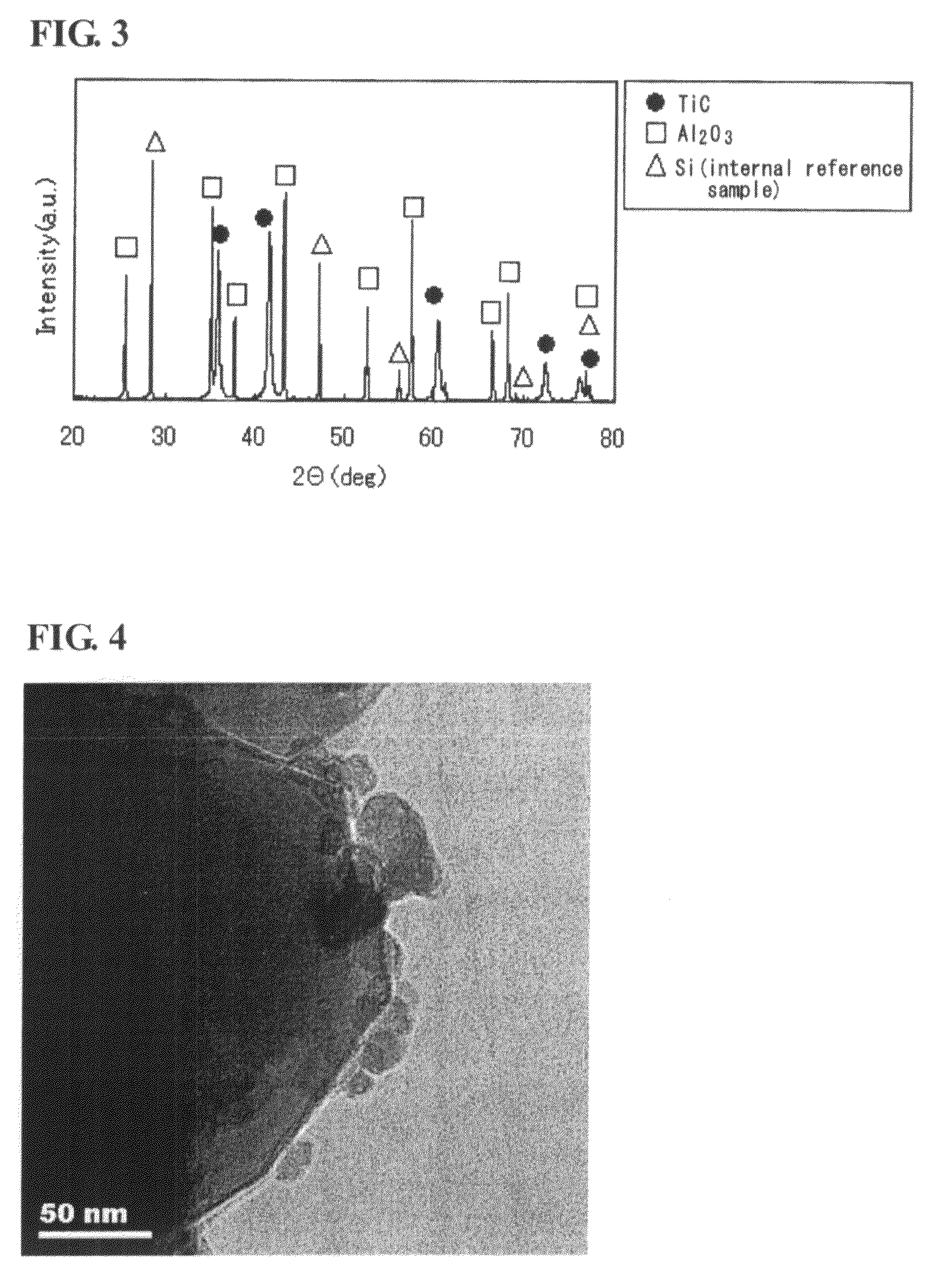Titanium carbide powder and titanium carbide-ceramics composite powder and method for production thereof, and sintered compact from the titanium carbide powder and sintered compact from the titanium carbide/ceramics composite powders and method for production thereof
a titanium carbide and composite powder technology, applied in titanium carbide, inorganic chemistry, domestic applications, etc., can solve the problems of high probability of residual voids or pores in the sintered body, deterioration in strength of the sintered body, and poor sinterability of the titanium carbide, so as to suppress the growth of titanium carbide particles and reduce the size of grain size , the effect of excellent mass productivity
- Summary
- Abstract
- Description
- Claims
- Application Information
AI Technical Summary
Benefits of technology
Problems solved by technology
Method used
Image
Examples
example 1
[0076]20 g of salicylic acid having a molecular mass of 138.1 serving as a carbon source was added to 60 ml of 2-methoxyethanol serving as a solvent, and the mixture was stirred to dissolve the carbon source in the solvent so as to obtain transparent and colorless liquid serving as raw material of precursor.
[0077]46.4 g of titanium isopropoxide which has titanium content of about 7.8 g and molecular mass of 284.2, and is in liquid form at room temperature, was added to the liquid, and the mixture was stirred to obtain a highly-transparent homogenous reddish brown composition having salicylic acid substituted and coordinated for / to a part of titanium isopropoxide. The mixture was successively stirred for 2 hours, and then heated with stirring in an oil bath to obtain a dried product. This dried product has an orange color, and a molar ratio “α” of salicylic acid serving as a carbon source to titanium isopropoxide serving as a titanium source of 0.9.
[0078]Then, in a graphite crucible ...
example 2
[0083]62 g of salicylic acid serving as a carbon source was added to 170 ml of 2-methoxyethanol serving as solvent, and the mixture was stirred to dissolve the carbon source in the solvent so as to obtain a transparent and colorless liquid serving as raw material of precursor.
[0084]130 g of titanium isopropoxide which has titanium content of about 22 g and is in liquid form at room temperature, was added to the liquid, and the mixture was stirred to obtain a highly-transparent homogenous reddish brown composition having salicylic acid substituted and coordinated for / to a part of titanium isopropoxide. The mixture was successively stirred for 2 hours, and then 46 g of alumina powder was added to the mixture. The obtained mixture was stirred using a stirrer for 3 hours, and then heated with stirring in an oil bath to obtain a dried product. This dried product has an orange color, and a molar ratio “α” of salicylic acid serving as the carbon source to titanium isopropoxide serving as a...
example 3
[0089]The titanium carbide-covered alumina powder obtained in Example 2 was put in a carbon mold, and subjected to a hot pressing process under an argon atmosphere at a press pressure of 25 MPa and a press temperature of 1800° C. for 90 minutes, to obtain a sintered body having a length of 50 mm, a width of 50 mm and a thickness of 4 mm. A density of the sintered body was measured by an Archimedes' method. As a result, it was proven that the sintered body has a density of 4.27×103 kg / m3, and a relative density of 99.5%.
[0090]Then, the sintered body was subjected to surface polishing, and then subjected to mirror-like finishing based on lapping using a tin plate. The finished sintered body was observed using a scanning electron microscope (SEM).
[0091]FIG. 5 shows a SEM photograph of a mirror-finished surface of the obtained alumina-titanium carbide composite sintered body. As seen in this photograph, titanium carbide particles are homogenously distributed in the sintered alumina. In ...
PUM
| Property | Measurement | Unit |
|---|---|---|
| particle size | aaaaa | aaaaa |
| temperature | aaaaa | aaaaa |
| temperature | aaaaa | aaaaa |
Abstract
Description
Claims
Application Information
 Login to View More
Login to View More - R&D
- Intellectual Property
- Life Sciences
- Materials
- Tech Scout
- Unparalleled Data Quality
- Higher Quality Content
- 60% Fewer Hallucinations
Browse by: Latest US Patents, China's latest patents, Technical Efficacy Thesaurus, Application Domain, Technology Topic, Popular Technical Reports.
© 2025 PatSnap. All rights reserved.Legal|Privacy policy|Modern Slavery Act Transparency Statement|Sitemap|About US| Contact US: help@patsnap.com



